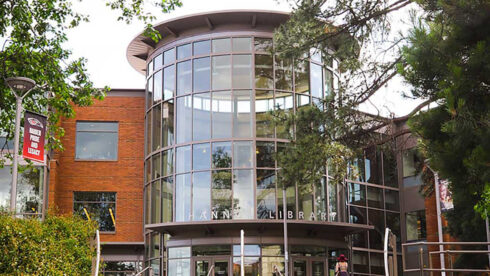This morning, the tuition fee rate for Southern Oregon University was raised to 5.8 percent by a simple majority vote among participants at a meeting consisting of administrators, staff, and faculty.
This increase has disappointed members of the Associated Students of Southern Oregon University, who attended the meeting advocating for a zero percent increase across the whole state.
According to Student Body President Joshua Danielson, an increase of any amount after last year’s tuition cost increase of nearly ten percent is “unacceptable” and “mind-boggling.”
“We are balancing our checkbooks on the backs of students,” Danielson said at the meeting. “Enough is enough.”
SOU Clubs Senator Justin Silva agreed. “If we continue raising tuition to the point of California, you’re going to lose half your students,” he warned.
The meeting was presided over by SOU’s Vice President of Finance and Administration Craig Morris and Provost James Klein, who started the meeting by displaying a “Budget Pro Forma” chart showing a long-term view of SOU’s present financial situation and projecting four years into the future.
“I know you’ve got this OSA [Oregon Student Association] thing,” Klein told Danielson. “You can chant ‘zero percent, zero percent!’ But if we go into bankruptcy, what good does that do anybody?”
According to Morris, the purpose of the meeting was to negotiate these tensions and agree on a recommendation to be presented in April to SOU’s president Mary Cullinan on how the university will get out of its current budget decline. The pro forma chart was a model in which numbers could be inserted to see what would happen as a result.
Throughout the two-hour meeting, participants called out various numbers and figures to see how they would play out in Morris’ model.
“We could be here all day just playing with numbers,” Morris said.
The challenge was to find out what changes in financial planning would bring SOU to the minimum standard of five percent of the total fund balance required by the state for its colleges and universities. A deficient balance below the minimum results in a process called retrenchment.
SOU had to experience a retrenchment process in the 2006-2007 school year due to serious financial and enrollment challenges.
“If we fall below the minimum acceptable standard of five percent, a comprehensive plan must be made to the board on how we are going to get out of the hole,” Morris explained.
Much of the discussion turned toward Oregon’s Public Employee Retirement System, which has been targeted for much-needed reforms by the Oregon Legislature since last February. The PERS reform proposals seek to relieve pressure being exerted on core services by the state’s $14 billion deficit and redirect some of the money that has been siphoned away from such services, especially higher education.
Alissa Arp, dean of the College of Arts and Sciences at SOU, took a consistently realist position throughout the meeting. While agreeing that something must be done at the state level to decrease costs of higher education, she drove home the problem of logistics.
“But how are we going to do that?” Arp repeatedly asked during the meeting.
Robert Ellis Cochran, vice president of ASSOU’s executive team, said the constructive criticism was helpful to the discussion.
“I appreciate how the question is phrased,” he told Arp. “I like that it’s a solution-based question, because it helps me to think.”
Arp turned the discussion to the question of what programs and services to cut, a move she said would be necessary in order to make ASSOU’s plan of a zero percent tuition cost increase possible.
“Tell us what to cut,” she said. “Would the students want us to cut all of athletics? Chop off a hand here or a whole arm there?”
Ideas for cutbacks ranged from drastic to progressive. One attendant wondered if it was not a good idea to cut the music and theater departments of the university altogether. Another attendant suggested saving money by switching to a “textbook-free campus.”
Arp said there was only one feasible aspect of university life to cut.
“The only place we can make significant cuts is in faculty,” she said. “When it comes to cutting, it’s to faculty lines. We need regimented lines of cuts. No offense to any faculty in the room, but we may have to cut faculty members not performing well.”
But Danielson expressed optimism at the feasibility of not increasing tuition costs by any amount by appealing to the ambitious prioritization project SOU is undertaking, as well as various “innovative measures” such as the Honors College and new state-of-the-art housing complex.
But Arp was skeptical of this and pointed out that prioritization has nothing to do with money. Claude Akins, chief of staff of the executive branch of ASSOU, also pointed out that the current problem lies in the interim between now and the implementation of new innovative programs at the university.
“Essentially this is just about keeping the doors open until prioritization and the new innovations kick in, in 2017-ish,” Akins said.
Before a vote was taken, Morris wrapped up the meeting by stating his position that raising tuition costs was the only feasible option.
“I have kept my mouth shut so far, but we have to position ourselves. I will not support going too low on tuition,” he said.
Among those eligible to vote, 16 voted for raising tuition by 5.8 percent, four voted against the move, and four abstained from voting.


